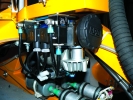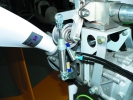
South African pneumatics specialist, Festo, has taken on the project of designing a pulley tensioning device for a Magni Gyro autogyro.
Festo was approached to develop and install a replacement device for a manually activated jockey pulley tensioning device on the autogyro. The tensioning device provides tension between two fan belts running on a set of pulleys leading from the crankshaft to the top rotor starting pulley. During start up the top rotor is brought into motion with the aid of engine power. After this initial start up, the forward motion of the autogyro keeps the rotor in motion and acts as a 'wing' to keep the autogyro in the air. The factory-fitted device comprised a lever similar to those used on a bicycle brake connected to a cable leading to the jockey pulley tensioning device. A solution was required that enabled the pilot to control this start up procedure via a switch located on the steering stick.

According to Bruce Rainbird, Festo internal sales, this was accomplished using pneumatic control.
"The operational control was the most challenging to design into the tensioning device as progressive tension on an incremental basis was required in order to ensure a smooth as well as incremental transfer of power to the main rotor pulley. Once the main rotor was at a desired speed, the power transmission (tension on v-belts) had to be immediately released that is, slow incremental and controlled tensioning with a spring return."

Festo used a normally open solenoid valve, normally closed solenoid valve, 16 mm diameter standard cylinder, non return valve, and one-way flow control valve as the main components of the design. Rainbird explains: "As soon as power is delivered to the system, the normally open valve would close allowing air-pressure from the pilot side of the non return valve to fall away ensuring air-flow in only one direction. By activating the normally closed valve (toggle switch), air is delivered via the one way flow control valve and the non return valve to the cylinder causing a slow pulling action."
If the toggle switch is released, air delivery is stopped and the piston position is retained by the non return valve. If more tensioning is needed the toggle switch is activated and air delivered to the cylinder. On completion of the start up procedure, the power to the system is switched off, the normally open solenoid returns to open and pressure is delivered to the pilot side of the non return valve allowing air to escape from the cylinder at a rapid rate ensuring the 'spring return'.
A major safety benefit from the switching off on de-activation is that the procedure cannot be activated in flight thus avoiding any possible damage.
An autogyro is so named because it is an aircraft that derives its lift from an un-powered main rotor that windmills freely under autorotation. To climb, or remain aloft, the autogyro is most often thrust forward by means of a pusher propeller at the rear of the machine. To shorten the take-off run, some autogyros are equipped with a pre-rotation mechanism that allows power from the pusher-engine to be used to get the main rotor up to speed before commencing the takeoff run. On a more trivial note, just as aeroplanes are called 'airplanes' by some folk, autogyros are also called 'gyrocopters', which loses the original derivation by dropping the 'auto' - Ed.
| Email: | [email protected] |
| www: | www.festo.co.za |
| Articles: | More information and articles about Festo South Africa |

© Technews Publishing (Pty) Ltd | All Rights Reserved